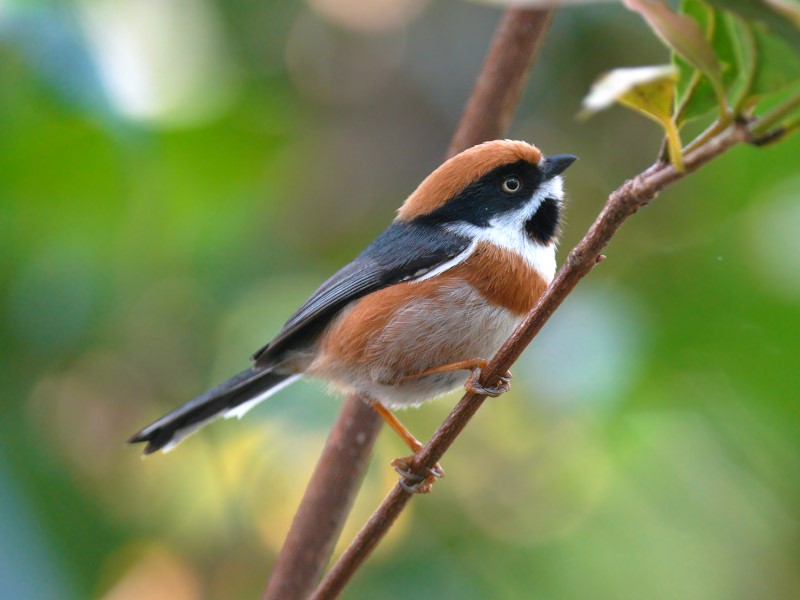Black-throated Bushtit Aegithalos concinnus 紅頭長尾山雀
Category I. Scarce and localised resident and/or winter visitor to mature woodland mainly in the Tai Mo Shan massif.
IDENTIFICATION

Feb. 2021, Roman Lo.
8.8 – 11.5 cm. Small and strikingly plumaged making identification in a HK context straightforward. The combination of orange crown, black mask and isolated throat patch, white irides, orange breast band and flanks and sooty upperparts are highly distinctive. Juveniles have a paler crown, duller and browner upperparts, dull whitish throat, dull buff belly and variable spotting or streaks across the chest.
VOCALISATIONS
Flocks utter a constant stream of contact and other calls as they play ‘follow my leader’ through the canopy. Geldard et al. (2023) list four types of vocalisation for the Black-throated Tit taxa that occur in China. These are a high-pitched ‘trill’, a slightly lower-pitched ‘sputter’, a flat, clipped ‘chip’ and a high-pitched ‘sit’ that is usually uttered as a double or triple note. All these can be heard in the following recording.
DISTRIBUTION & HABITAT PREFERENCE
Occurs in mature secondary forest primarily in the Tai Mo Shan massif. There have been occasional records from Kowloon Hills and Lion Rock CP, but there is no suggestion it has established east of there in Sai Kung or even Ma On Shan CP. Single records at Beacon Hill, Ma Tau Wai and Uk Tau (Sai Kung West CP) may refer to ex-captive birds, but the presence of up to three on Po Toi from 25 December 2012 to 26 February 2013 suggests the possibility of natural arrival.
OCCURRENCE
The first record of Black-throated Bushtit was of two birds on Lamma on 19 December 1976. Records of possibly ex-captive birds occurred in 1986 and 1987, but from 1989 there were reports from several locations, mostly Tai Po Kau and elsewhere on the Tai Mo Shan massif, but also HK Island, Cheung Chau, Kowloon Hills, Ho Chung and Mai Po. Until 1992 all records occurred in the winter months, but in that year an upsurge in records saw the first evidence of breeding when nest-building was noted at Tai Po Kau. Subsequently breeding was noted there and at Aberdeen CP and Tai Lam Chung up to 1997.
Initially it was considered that, despite there being what appears to be ample suitable habitat, in view of the fact that early records referred to singles in urban or semi-urban localities, birds in HK had not arrived naturally. However, the large numbers of birds in the mid-1990s (the highest count being 20 on 18 June 1997 at Tai Lam Chung) and multiple breeding records saw a re-evaluation of its status such that it was placed in Category I. Despite the decline in numbers recorded since then, the occurrence of birds at such localities as Po Toi indicates it may still be occurring naturally. In addition, since 1999 nearly all double-figure counts have occurred in the period from 15 July to 24 September, suggesting that there is still a breeding population locally (though not necessarily in HK).
BREEDING
Four to five adults were recorded feeding a juvenile at Aberdeen CP on 1 May 1993 and recently-fledged young were seen at Kam Tin in 1997.
BEHAVIOUR, FORAGING & DIET
Often in small parties of foraging birds moving rapidly through the canopy, the highest flock count is 15. Readily joins mixed species flocks.
RANGE & SYSTEMATICS
Breeds across the Himalayas to south China (including areas north of the Changjiang (Yangtze River)), northern Myanmar and south Vietnam (Geldard et al. 2023). In China breeds in most of south China south of the Huang He (Yellow River) (Liu and Chen 2021).
Seven subspecies are recognised, the nearest of which is the nominate form, which occurs in southeast mainland China, Taiwan and northeast Vietnam. However, it is uncertain which taxon occurs in HK.
CONSERVATION STATUS
IUCN: Least Concern. Population trend decreasing.
Geldard, R. P., S. Harrap, J. del Hoyo, D. A. Christie, N. Collar, G. M. Kirwan, and A. J. Spencer (2023). Black-throated Tit (Aegithalos concinnus), version 2.1. In Birds of the World (S. M. Billerman and B. K. Keeney, Editors). Cornell Lab of Ornithology, Ithaca, NY, USA. https://doi.org/10.2173/bow.blttit2.02.1
Liu, Y. and S. H. Chen (eds) (2021). The CNG Field Guide to the Birds of China (in Chinese). Hunan Science and Technology Publication House, Changsha.

